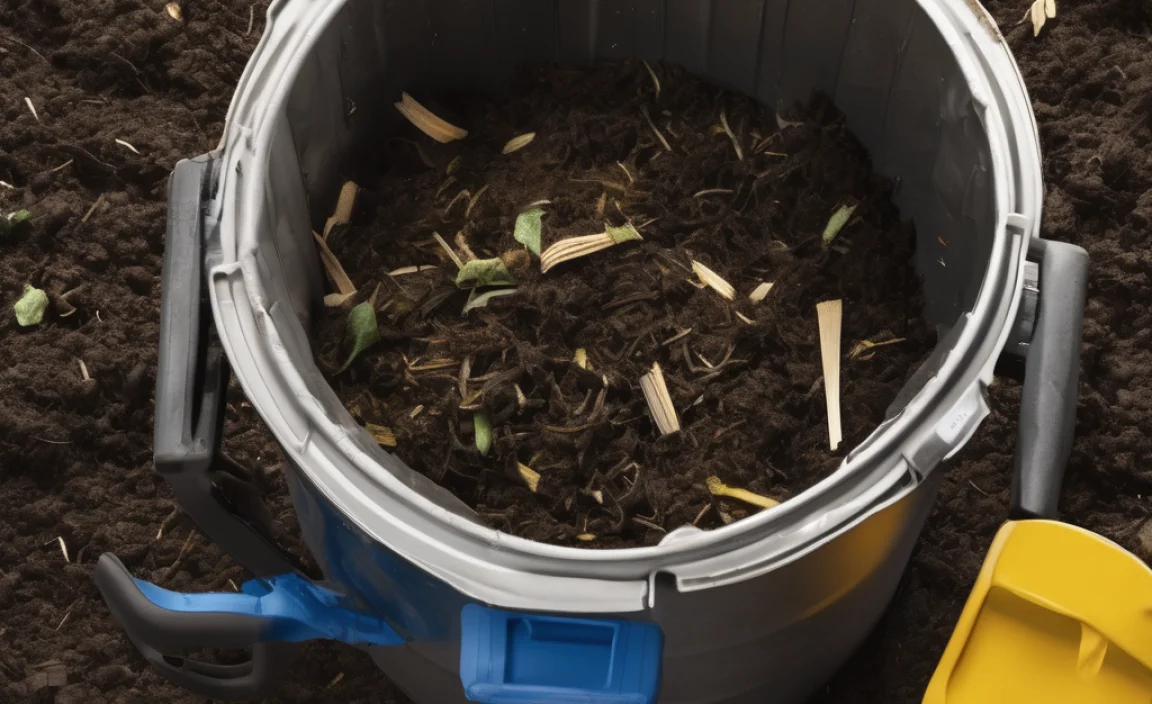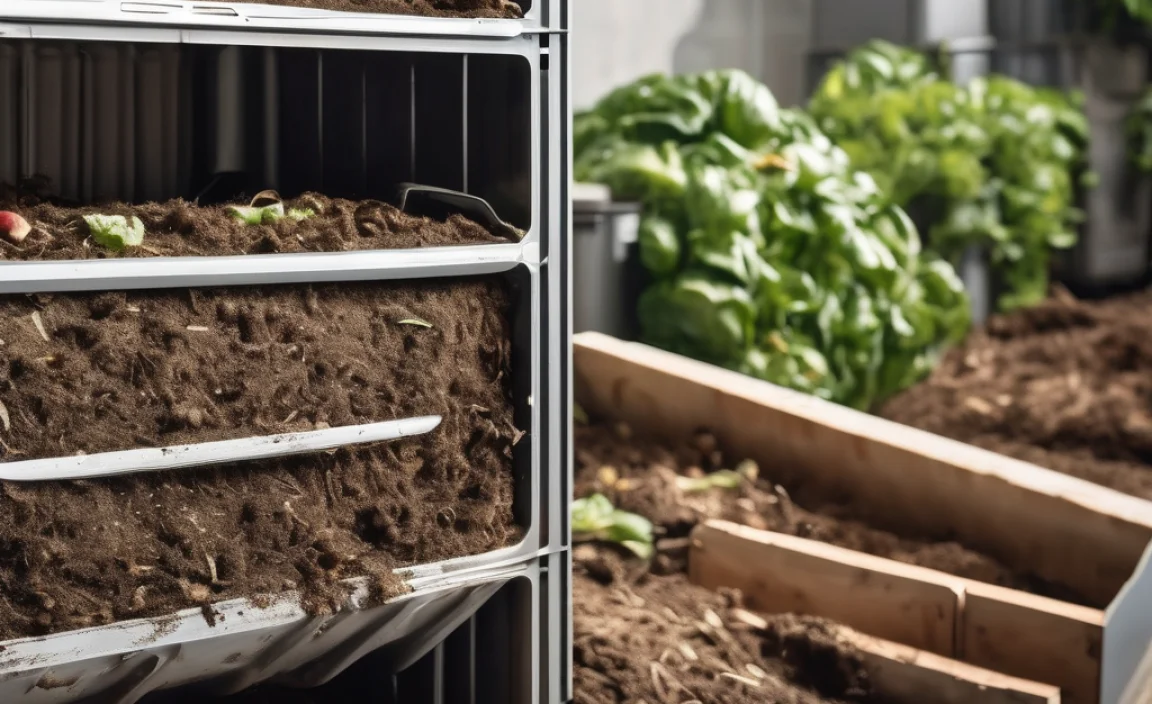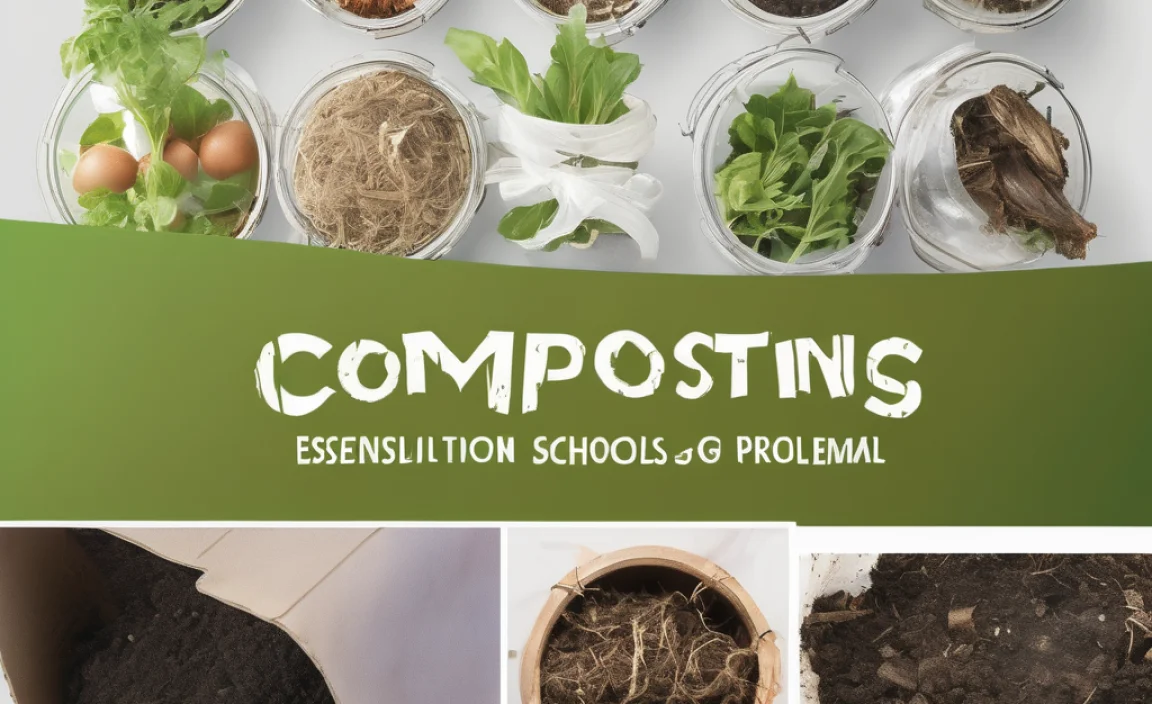Got food scraps piling up at school? Wondering how to tackle composting challenges in an educational setting? You’re not alone! Many schools face hurdles when trying to start or maintain a composting program. It can seem overwhelming, but with the right approach, you can make a big difference. We’ll walk you through the common problems and offer simple, doable solutions.
Let’s get composting at your school the easy way!
Imagine a school where food waste transforms into rich soil, where students learn firsthand about sustainability, and where the cafeteria doesn’t send mountains of trash to the landfill. Setting up a composting program in a school is a fantastic way to teach valuable lessons and reduce environmental impact. However, it’s not always as straightforward as it looks. Schools have unique challenges, from managing large volumes of waste to engaging a whole community of students, staff, and parents.
But don’t worry! We’ll break down the common snags and provide practical, step-by-step solutions. You’ll learn how to overcome issues like smelly bins, pests, lack of buy-in, and more. This guide is designed to be super easy to follow, even if you’re new to composting or school green initiatives.
Why Composting in Schools Matters

Before we dive into the problems and solutions, let’s quickly touch on why this is such a big deal. Schools generate a lot of waste, especially from food served in cafeterias and snacks. Composting helps divert this organic material from landfills, where it produces harmful methane gas. Instead, it becomes a valuable resource for gardens, improving soil health and reducing the need for chemical fertilizers.
Beyond the environmental benefits, school composting programs are incredible educational tools. They teach students about the food cycle, waste reduction, and the importance of caring for our planet. It’s a hands-on way to learn about science, ecology, and civic responsibility.
Some of the most pressing reasons for implementing school composting include:
- Reducing landfill waste significantly.
- Lowering greenhouse gas emissions.
- Creating nutrient-rich compost for school gardens or local farms.
- Providing tangible learning experiences for students.
- Fostering a school-wide culture of sustainability.
Common Composting for Schools Problems

Starting and running a composting program in a school can present some unique challenges. It’s like trying to manage a small city’s waste, but with kids involved! Let’s look at the most frequent issues schools face and why they pop up.
1. Odor and Pests
This is probably the number one concern people have. Unpleasant smells and attracting critters like rodents or flies can make a composting program a no-go zone. This usually happens when the compost pile isn’t balanced correctly, has too much “wet” material (like fruit and veggie scraps), or isn’t getting enough air.
At school, you might have volunteers or students in charge of managing the compost. If they don’t have a solid understanding of what goes in and what to do, errors can quickly lead to these problems. Large volumes of food waste from lunch can also overwhelm a small or poorly managed system.
2. Contamination of Compost Materials
Unlike a home garden where you control the input, schools have many people adding scraps. It’s common for non-compostable items like plastic wrappers, utensils, milk cartons, or even tissues to accidentally end up in the compost bins. This contamination can ruin batches of compost, requiring extra time and effort to sort or even making the material unusable.
With hundreds or thousands of students and staff, educating everyone on what’s compostable and what’s not is a monumental task. Clear signage and consistent training are key, but mistakes are bound to happen.
3. Lack of Space and Suitable Location
Schools, especially urban ones, can be short on outdoor space. Finding a spot for compost bins that is accessible for waste collection, out of the way of regular school activities, and doesn’t bother neighbors can be tricky. The compost area needs to be large enough to accommodate the waste generated and the composting process itself, which can involve turning piles or managing bins.
If the location is too close to buildings, it can cause aesthetic or olfactory issues. If it’s too far or hard to access, it makes the collection process difficult and time-consuming for staff or student volunteers.
4. Engagement and Participation from the School Community
A composting program requires buy-in from everyone: students, teachers, cafeteria staff, custodians, and administration. If people aren’t on board, don’t understand the purpose, or find it inconvenient, participation will suffer. This can lead to poor collection of compostable materials and increased contamination.
Getting everyone motivated and consistently involved can be a huge hurdle. Teachers may feel they already have too much on their plates, students might lose interest after the initial novelty wears off, and cafeteria staff may see it as an extra chore.
5. Management and Maintenance Capacity
Who is going to turn the compost piles, monitor moisture levels, and troubleshoot problems? Schools often rely on the goodwill of a few dedicated staff members or parent volunteers. If these individuals leave or get too busy, the program can grind to a halt. There’s also the physical labor involved in managing compost, which can be challenging for some.
The ideal scenario involves dedicated personnel or a well-supported, rotating group of volunteers with the time and energy to keep the composting process running smoothly. This often requires administrative support and clear roles and responsibilities.
6. Cost of Equipment and Supplies
Setting up a composting system, even a simple one, can involve initial costs for bins, tools, and educational materials. While in the long run, it can save money on waste disposal fees, the upfront investment can be a barrier for budget-conscious schools. Ongoing costs for repairs, replacement parts, or educational materials also need to be considered.
Schools might need sturdy, animal-proof bins, shovels for turning, possibly tumblers, and signs. While DIY options exist, investing in quality equipment is often more reliable and less problematic in the long run.
7. Educational Curriculum Integration
To make a composting program truly impactful and sustainable, it needs to be more than just a waste management task. It should be integrated into the school’s curriculum. However, finding the time and resources to link composting activities with science lessons, environmental studies, or even math projects can be a challenge for educators.
Without this integration, the program might be seen as an extracurricular add-on rather than a core part of learning, which can affect long-term commitment and understanding.
Essential Solutions for Composting for Schools Problems

Now that we’ve identified the common headaches, let’s roll up our sleeves and tackle them with practical, easy-to-implement solutions. These are designed to be straightforward, so you can start making progress right away.
1. Tackling Odor and Pests
The key to a smell-free, pest-free compost is balance and aeration. Think of it like baking a cake – you need the right ingredients in the right proportions.
- Balance Greens and Browns: Compost needs a mix of nitrogen-rich “greens” (food scraps, grass clippings) and carbon-rich “browns” (leaves, shredded paper, cardboard). A good ratio is roughly 2 parts browns to 1 part greens by volume. If it smells swampy, it probably has too many greens or is too wet. Layer in more browns!
- Ensure Good Aeration: Compost needs air to break down properly. If you’re using bins, make sure they have holes or are turned regularly. For piles, turning them every week or two with a pitchfork or compost aerator is crucial. Tumblers make this easier. Good airflow prevents “anaerobic” decomposition, which causes foul odors.
- Manage Moisture: Your compost should feel like a wrung-out sponge – damp but not soaking wet. If it’s too wet, add more browns. If it’s too dry, add a little water. Covering the compost during heavy rain can help regulate moisture.
- Use Proper Bins: For schools, pest-proof bins are essential. Look for enclosed tumblers or sturdy bins with tight-fitting lids and good ventilation.
- Bury Food Scraps: When adding fresh food scraps, try to bury them under a layer of browns. This helps deter pests and reduce odors.
Here’s a quick look at what goes where:
| Greens (Nitrogen-Rich) | Browns (Carbon-Rich) | What NOT to Compost |
|---|---|---|
| Fruit and vegetable scraps | Dry leaves | Meat, fish, bones, dairy products (can attract pests and cause odors) |
| Coffee grounds and tea bags | Shredded newspaper and cardboard (avoid glossy paper) | Oily foods and grease |
| Grass clippings | Wood chips or sawdust (in moderation) | Diseased plants |
| Eggshells | Straw | Pet waste (dog/cat feces) |
2. Preventing Contamination
Education is your strongest tool here. Make it super simple and visual for everyone involved.
- Clear Signage: Use bright, colorful signs with pictures on all compost collection bins. Show exactly what can and cannot go in. Keep it simple and to the point.
- Color-Coded Bins: Use different colored bins for trash, recycling, and compost in the cafeteria and classrooms. This makes it intuitive for students to sort their waste.
- Consistent Training: Conduct brief, engaging training sessions for students, teachers, and cafeteria staff at the beginning of the year and periodically. Make it fun!
- “Compost Captains” or “Green Teams”: Empower student groups to monitor bins, help younger students sort their waste, and be champions for the program.
- Audits and Feedback: Regularly check the collection bins and compost area for contaminants. Provide constructive feedback to the relevant groups (e.g., a specific class or lunch period) in a non-punitive way.
- Cafeteria Staff Involvement: Work closely with cafeteria staff to ensure they are properly trained and have convenient composting collection points for kitchen prep waste.
3. Finding Space and a Suitable Location
Get creative with the space you have. Sometimes a little planning goes a long way.
- Assess Your Site: Walk around the school grounds. Consider areas that are:
- Accessible for waste collection (from cafeteria, classrooms).
- Well-drained to avoid waterlogging.
- Receiving some sunlight (helps with warmth and decomposition) but not scorching heat all day.
- Away from high-traffic areas to minimize noise and odor concerns.
- Secure enough to deter vandalism but accessible for authorized personnel.
- Utilize Underused Areas: Look for nooks and crannies, behind buildings, or at the edge of sports fields or garden areas.
- Consider Bin Types: If space is tight, consider vertical composting systems or smaller, more manageable tumblers.
- Work with Administration: Present a clear plan to school administration highlighting the benefits and how you’ve addressed potential concerns like location and aesthetics.
- Partner with a School Garden: Often, the best place for a compost system is adjacent to a school garden. It’s a natural fit, and the compost is immediately useful.
For more detailed guidance on choosing a compost system for your needs, the U.S. Environmental Protection Agency (EPA) offers excellent resources on composting methods.
4. Boosting Engagement and Participation
Make it a community effort. When people feel invested, they’ll participate.
- Involve Students from the Start: Let students participate in planning, designing, and naming the composting program. This gives them ownership.
- Make it Educational and Fun: Connect composting to classroom lessons. Organize contests (e.g., who can collect the most “browns”), composting workshops, or compost-related science experiments.
- Celebrate Successes: Publicly acknowledge and celebrate milestones. Share photos, update the school newsletter, and highlight the positive impact the program is having.
- Appoint Champions: Designate teacher sponsors, parent coordinators, or enthusiastic student “Compost Commanders” to lead the charge and keep momentum going.
- Involve the Whole School: Host events like a “Compost Day” or a cafeteria waste reduction challenge. Make it a visible part of the school’s identity.
- Communicate Clearly and Consistently: Use multiple channels – assemblies, newsletters, bulletin boards, school websites – to keep everyone informed about how the program is going and why it’s important.
5. Building Management and Maintenance Capacity
Ensure the program has a stable foundation and support system.
- Establish Clear Roles and Responsibilities: Define exactly who is responsible for what, from daily collection to weekly turning and troubleshooting.
- Create a Rotating Schedule: If relying on volunteers or student groups, create a rotating schedule to spread the workload and prevent burnout.
- Seek Custodial and Staff Support: Work closely with custodians and cafeteria staff. Their input is invaluable for practicality, and their support is crucial for collection and logisti cs.
- Train Your Team: Provide thorough training for anyone involved in managing the compost. Offer resources and ongoing support.
- Simplify the Process: Use easy-to-manage compost systems like tumblers or well-designed bins that require minimal physical exertion.
- Administration Support: Secure official support from school administration. This can help allocate time, resources, and designate staff as key personnel for the program.
6. Managing Costs of Equipment and Supplies
Start smart and look for funding opportunities.
- Start Small and Scale Up: You don’t need a massive industrial system to start. Begin with a few well-chosen bins and expand as the program proves successful and funding becomes available.
- DIY Options: Many effective compost bins can be built from recycled materials like wooden pallets or repurposed plastic drums. Look for online guides and tutorials.
- Seek Grants and Donations: Many environmental organizations, local garden clubs, or businesses offer grants for school sustainability projects. Local hardware stores or garden centers might donate materials or offer discounts.
- Incorporate into Budget Planning: Work with school administration to include compost program needs in the annual budget. Highlight potential savings on waste disposal fees as a justification.
- Utilize School Resources: Can parts of the system be built by students in a shop class? Can the grounds crew help with site preparation?
For inspiration on building your own compost bin, resources like ATTRA’s Composting Manual (though more comprehensive) offers principles that can be applied to DIY projects.
7. Integrating into the Curriculum
Make composting a living lesson!
- Tie into Science: Use the compost pile to teach about decomposition, microorganisms, nutrient cycles, and soil science. Students can measure temperature, moisture, and material breakdown.
- Math Applications: Have students calculate the volume of waste diverted, measure compost ratios, or track growth rates in plants grown with compost.
- Environmental Studies: Discuss the impact of waste on the environment, the benefits of composting, and the concept of a circular economy.
- Art and Writing Projects: Students can create artwork, poems, or stories inspired by the composting process or its benefits.
- Connect to School Gardens: If your school has a garden, use compost directly in planting and harvesting activities. This makes the connection very tangible.
- Collaborate with Teachers: Work with teachers to identify opportunities within their existing lesson plans to incorporate composting activities.
The EPA’s section on schools provides broader context and ideas for environmental education initiatives that can be linked to composting.
Tips for Choosing the Right Composting System for Your School

The best system depends on your school’s size, available space, budget, and the amount of waste generated. Here’s a quick rundown:
| System Type | Pros | Cons | Best For |
|---|---|---|---|
| Open Piles | Simple, low cost, can handle large volumes. | Requires space, can attract pests if not managed well, slower decomposition. | Schools with ample space and a dedicated composting team. |
| Enclosed Bins (Stationary) | Neater, helps retain heat and moisture, deters |

I am passionate about home engineering. I specialize in designing, installing, and maintaining heating, ventilation, and air conditioning systems. My goal is to help people stay comfortable in their homes all year long.

